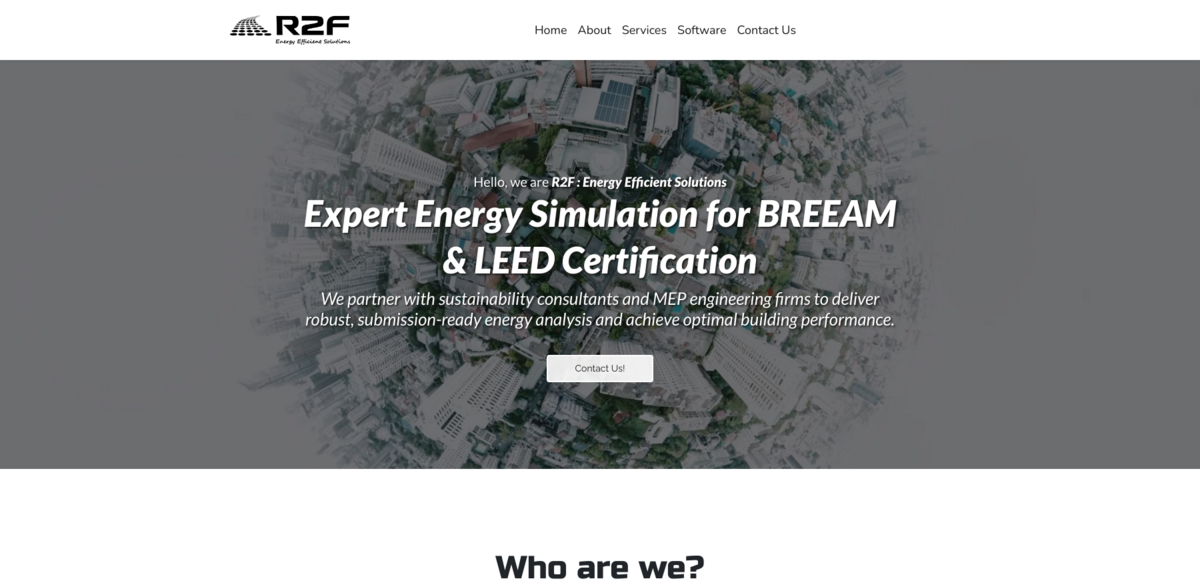What is R2F Energy Efficient Solutions?
R2F Energy Efficient Solutions is all about expert energy simulation tailored for BREEAM and LEED certification. They team up with sustainability consultants and MEP engineering firms to deliver solid, submission-ready energy analysis that helps achieve top-notch building performance. Think of them as the go-to specialists who dive deep into the technical nitty-gritty—like ASHRAE 90.1 standards and thermal comfort—so project teams can keep their eyes on the bigger picture: client satisfaction and project success.
Main Benefits of Partnering with R2F
Here’s what R2F brings to the table:
- Building Energy Modeling that’s precise and reliable
- Residential Energy Rating to meet stringent standards
- Support for Sustainable Building Certification processes
- Comprehensive Energy Management strategies
- Thorough Energy Audits to identify savings
- Expertise in Renewable Energy integration
Specialized Software Skills Driving Success
R2F leverages a suite of powerful software tools to ensure accuracy and compliance. TRNSYS, for example, is a simulation program widely used in building and renewable energy engineering—covering everything from solar thermal processes to photovoltaic systems. Then there’s OpenStudio, which supports whole building energy modeling with EnergyPlus and advanced daylight analysis using Radiance. EnergyPlus itself models energy consumption across heating, cooling, ventilation, lighting, and more. For detailed thermal bridge analysis, THERM uses finite-element methods to model heat transfer in building components. In Belgium, the PEB software is the official tool to verify energy performance compliance. And, of course, Python plays a big role, with its vast ecosystem of open-source packages like Numpy, Pandas, CoolProp, and pvlib, making custom simulations and data analysis a breeze.
Who Relies on R2F’s Expertise?
Sustainability consultants, BREEAM and LEED assessors, and MEP engineering firms count on R2F to handle the complex technical aspects of energy simulation. This partnership means these professionals can focus on their clients and the overall project goals, while R2F ensures the energy analysis is robust, accurate, and ready for submission. It’s a win-win that streamlines the certification process and boosts confidence in achieving energy credits.
How Does R2F Ensure Compliance and Quality?
By delivering a comprehensive evidence package that meets all certification requirements, R2F guarantees compliance with standards like ASHRAE 90.1 and others. Their detailed simulations and audits provide the solid proof needed to maximize energy credits and support sustainable building certification efforts. This meticulous approach reduces risks and helps projects sail through certification with flying colors.
Project Impact on Sustainable Development Goals (SDGs)
- SDG 7: Affordable and Clean Energy
- SDG 9: Industry, Innovation, and Infrastructure
- SDG 11: Sustainable Cities and Communities
- SDG 12: Responsible Consumption and Production
- SDG 13: Climate Action
Why Energy Simulation Matters in Today’s World
Energy simulation isn’t just a checkbox for certification—it’s a critical step toward smarter, greener buildings. With climate change and energy costs on everyone’s mind, having accurate models that predict energy use and identify savings opportunities is more important than ever. R2F’s expertise helps projects not only meet regulations but also push the envelope on sustainability and efficiency. In a nutshell, energy simulation is the secret sauce behind buildings that perform better, cost less to run, and have a smaller environmental footprint.





















